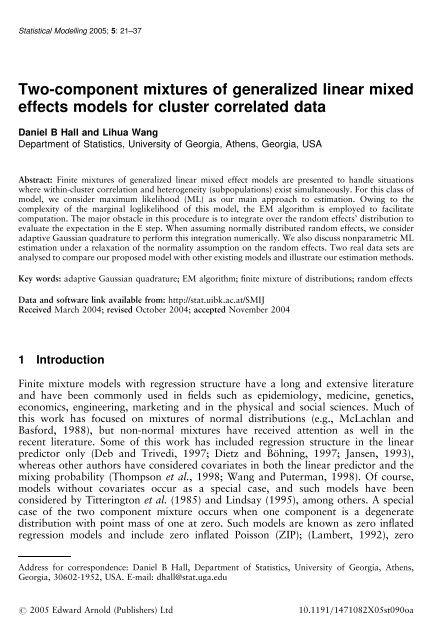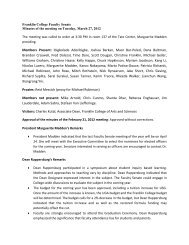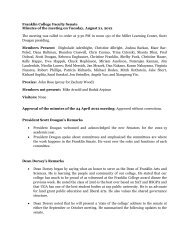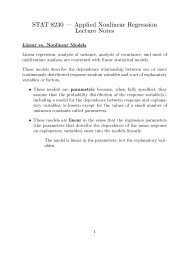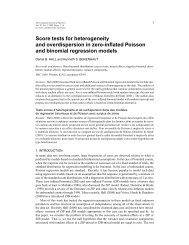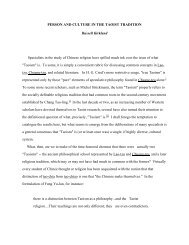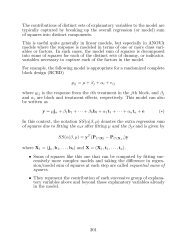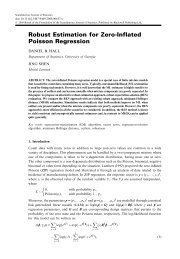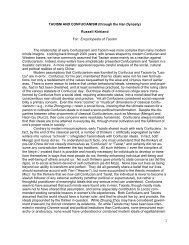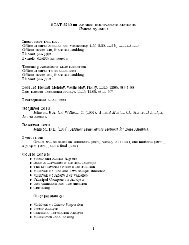Two-component mixtures of generalized linear mixed effects models ...
Two-component mixtures of generalized linear mixed effects models ...
Two-component mixtures of generalized linear mixed effects models ...
Create successful ePaper yourself
Turn your PDF publications into a flip-book with our unique Google optimized e-Paper software.
Statistical Modelling 2005; 5: 21–37<br />
<strong>Two</strong>-<strong>component</strong> <strong>mixtures</strong> <strong>of</strong> <strong>generalized</strong> <strong>linear</strong> <strong>mixed</strong><br />
<strong>effects</strong> <strong>models</strong> for cluster correlated data<br />
Daniel B Hall and Lihua Wang<br />
Department <strong>of</strong> Statistics, University <strong>of</strong> Georgia, Athens, Georgia, USA<br />
Abstract: Finite <strong>mixtures</strong> <strong>of</strong> <strong>generalized</strong> <strong>linear</strong> <strong>mixed</strong> effect <strong>models</strong> are presented to handle situations<br />
where within-cluster correlation and heterogeneity (subpopulations) exist simultaneously. For this class <strong>of</strong><br />
model, we consider maximum likelihood (ML) as our main approach to estimation. Owing to the<br />
complexity <strong>of</strong> the marginal loglikelihood <strong>of</strong> this model, the EM algorithm is employed to facilitate<br />
computation. The major obstacle in this procedure is to integrate over the random <strong>effects</strong>’ distribution to<br />
evaluate the expectation in the E step. When assuming normally distributed random <strong>effects</strong>, we consider<br />
adaptive Gaussian quadrature to perform this integration numerically. We also discuss nonparametric ML<br />
estimation under a relaxation <strong>of</strong> the normality assumption on the random <strong>effects</strong>. <strong>Two</strong> real data sets are<br />
analysed to compare our proposed model with other existing <strong>models</strong> and illustrate our estimation methods.<br />
Key words: adaptive Gaussian quadrature; EM algorithm; finite mixture <strong>of</strong> distributions; random <strong>effects</strong><br />
Data and s<strong>of</strong>tware link available from: http://stat.uibk.ac.at/SMIJ<br />
Received March 2004; revised October 2004; accepted November 2004<br />
1 Introduction<br />
Finite mixture <strong>models</strong> with regression structure have a long and extensive literature<br />
and have been commonly used in fields such as epidemiology, medicine, genetics,<br />
economics, engineering, marketing and in the physical and social sciences. Much <strong>of</strong><br />
this work has focused on <strong>mixtures</strong> <strong>of</strong> normal distributions (e.g., McLachlan and<br />
Basford, 1988), but non-normal <strong>mixtures</strong> have received attention as well in the<br />
recent literature. Some <strong>of</strong> this work has included regression structure in the <strong>linear</strong><br />
predictor only (Deb and Trivedi, 1997; Dietz and Böhning, 1997; Jansen, 1993),<br />
whereas other authors have considered covariates in both the <strong>linear</strong> predictor and the<br />
mixing probability (Thompson et al., 1998; Wang and Puterman, 1998). Of course,<br />
<strong>models</strong> without covariates occur as a special case, and such <strong>models</strong> have been<br />
considered by Titterington et al. (1985) and Lindsay (1995), among others. A special<br />
case <strong>of</strong> the two <strong>component</strong> mixture occurs when one <strong>component</strong> is a degenerate<br />
distribution with point mass <strong>of</strong> one at zero. Such <strong>models</strong> are known as zero inflated<br />
regression <strong>models</strong> and include zero inflated Poisson (ZIP); (Lambert, 1992), zero<br />
Address for correspondence: Daniel B Hall, Department <strong>of</strong> Statistics, University <strong>of</strong> Georgia, Athens,<br />
Georgia, 30602-1952, USA. E-mail: dhall@stat.uga.edu<br />
# 2005 Edward Arnold (Publishers) Ltd 10.1191=1471082X05st090oa
22 DB Hall and L Wang<br />
inflated negative binomial, zero inflated binomial (ZIB); (Hall, 2000) and others<br />
(reviewed in Ridout et al., 1998).<br />
Recently, many researchers have incorporated random <strong>effects</strong> into a wide variety <strong>of</strong><br />
regression <strong>models</strong> to account for correlated response and multiple sources <strong>of</strong> variance.<br />
Generalized <strong>linear</strong> <strong>models</strong> (GLMs) with fixed and random (<strong>mixed</strong>) <strong>effects</strong> and normal<br />
theory non<strong>linear</strong> <strong>mixed</strong> <strong>effects</strong> <strong>models</strong> are two model classes that have attracted an<br />
enormous amount <strong>of</strong> attention in recent years (Davidian and Giltinan, 1995; 2003;<br />
McCulloch and Searle, 2001; e.g., for recent reviews). A recent example falling slightly<br />
outside the class <strong>of</strong> <strong>generalized</strong> <strong>linear</strong> <strong>mixed</strong> <strong>models</strong> (GLMMs) was provided by Booth<br />
et al. (2003) who considered log<strong>linear</strong> <strong>mixed</strong> <strong>models</strong> for counts based on the negative<br />
binomial distribution. In a mixture model context, van Duijn and Bockenholt (1995)<br />
presented a latent class Poisson model for analysing overdispersed repeated count data.<br />
Hall (2000) added random <strong>effects</strong> to ZIP and ZIB <strong>models</strong>. Zero inflated regression<br />
<strong>models</strong> with <strong>mixed</strong> <strong>effects</strong> for clustered continuous data have been considered by Olsen<br />
and Schafer (2001) and Berk and Lachenbruch (2002).<br />
In this paper, we formulate a class <strong>of</strong> regression <strong>models</strong> based on the two <strong>component</strong><br />
mixture <strong>of</strong> <strong>generalized</strong> <strong>linear</strong> <strong>mixed</strong> effect <strong>models</strong> (two-<strong>component</strong> GLMMs). This class<br />
can be viewed as an extension <strong>of</strong> finite <strong>mixtures</strong> <strong>of</strong> GLMs (Jansen, 1993) in which cluster<br />
specific random <strong>effects</strong> are included to account for within cluster correlation. Alternatively,<br />
it can be viewed as an extension <strong>of</strong> GLMMs in which a second <strong>component</strong> is added. We<br />
envision that finite <strong>mixtures</strong> <strong>of</strong> GLMMs will have application primarily in problems where<br />
there is some readily identified heterogeneity in the population so that the data represent a<br />
small number <strong>of</strong> subpopulations that cannot be directly identified except through the value<br />
<strong>of</strong> the response. We focus on the case in which it is reasonable to hypothesize two latent<br />
subpopulations underlying the data. For example, disease counts from epidemic and non<br />
epidemic years, weekly epileptic seizure counts from patients who have ‘good weeks’ and<br />
‘bad weeks’, arrhythmia counts from a sample <strong>of</strong> clinically normal patients that is<br />
contaminated with abnormal patients, counts from honest and dishonest self-reports<br />
pertaining to some stigmatized act, counts from adherers and non adherers to some<br />
study protocol, and so on. GLMs, finite <strong>mixtures</strong> <strong>of</strong> GLMs, ZIP, ZIB and many other<br />
<strong>models</strong> are special cases <strong>of</strong> this broad class.<br />
The difficulty <strong>of</strong> parameter estimation in mixture <strong>models</strong> is well known. A major<br />
advance came with the publication <strong>of</strong> the seminal paper <strong>of</strong> Dempster et al. (1977) on<br />
the EM algorithm. With the EM algorithm, latent variables or ‘missing data’ are<br />
introduced, which allows finite mixture <strong>models</strong> to be fit by iteratively fitting weighted<br />
versions <strong>of</strong> the <strong>component</strong> <strong>models</strong>. So, for example, a K <strong>component</strong> finite mixture <strong>of</strong><br />
GLMs can be fit via maximum likelihood (ML) by fitting K weighted GLMs, updating<br />
the weights and iterating to convergence. Mixture <strong>models</strong> with random <strong>effects</strong> pose an<br />
additional challenge to ML estimation as the marginal likelihood involves an integral<br />
that cannot be evaluated in closed form. This challenge is similar to that found with<br />
ordinary (nonmixture) GLMMs and other non<strong>linear</strong> <strong>mixed</strong> <strong>models</strong>.<br />
The paper is organized as follows: we formulate the two <strong>component</strong> mixture <strong>of</strong><br />
GLMMs in Section 2. In Section 3, we outline the EM algorithm and consider various<br />
methods <strong>of</strong> handling the required integration with respect to the missing data. The<br />
model class and estimation methods are illustrated with two real data examples in<br />
Section 4. Finally, we give a brief discussion in Section 5.
2 <strong>Two</strong>-<strong>component</strong> mixture <strong>of</strong> GLMMs<br />
Suppose, we observe an N-dimensional response vector y containing data from C<br />
independent clusters, so that y ¼ (y T 1 ; ...; yT C )T , where y i ¼ (y i1 ; ...; y ini ) T . We assume<br />
that, conditional on a q-dimensional vector <strong>of</strong> random <strong>effects</strong> b i , the random variable<br />
Y ij associated with observation y ij follows a two-<strong>component</strong> mixture distribution<br />
<br />
Y ij jb i F 1(y ij jb i ; z 1ij ; s 1 ); with probability p ij<br />
F 2 (y ij jb i ; z 2ij ; s 2 ); with probability 1 p ij<br />
Here, F 1 and F 2 are assumed to be exponential dispersion family distributions, with<br />
densities f k (y ij jb i ; z kij ; s k ) ¼ h k (y ij ; s k ) exp [{z kij y ij k k (z kij )}w ij =s k ], k ¼ 1; 2, respectively,<br />
where the w ij ’s are known constants (e.g., binomial denominators). The functions<br />
k 1 and k 2 are cumulant generating functions, so F 1 and F 2 have (conditional)<br />
means m 1ij ¼ k 0 1 (z 1ij) and m 2ij ¼ k 0 2 (z 2ij).<br />
We assume the canonical parameters f ki ¼ (z ki1 ; ...; z kini ) T , k ¼ 1; 2, are related to<br />
covariates and cluster specific random <strong>effects</strong> through GLM type specifications.<br />
Specifically, for canonical link functions, we assume<br />
f 1i (l 1i ) ¼ g 1i ¼ X i a þ U 1i D T=2<br />
1<br />
b 1i or l 1i ¼ f 1<br />
1i ¼ (g 1i )<br />
f 2i (l 2i ) ¼ g 2i ¼ Z i b þ U 2i D T=2<br />
2<br />
b 2i þ U 3i D T=2<br />
3<br />
b 1i or l 2i ¼ f 1<br />
2i (g 2i ) (2:1)<br />
Here, X i and Z i are n i r 1 and n i r 2 design matrices, respectively, for fixed <strong>effects</strong><br />
parameters a and b; b i ¼ (b T 1i; b T 2i) T , where b 1i and b 2i are <strong>of</strong> dimension q 1 and q 2 ,<br />
respectively, where q ¼ q 1 þ q 2 ; and U ki , k ¼ 1; 2; 3, are random <strong>effects</strong> design<br />
matrices. In some applications, we may drop the term U 3i D T=2<br />
3<br />
b 1i from the model, but<br />
in general it is present to allow covariance between the two <strong>linear</strong> predictors. We assume<br />
b 1 ; ...; b C are independent, identically distributed N q (0; I q ) vectors, and model covariance<br />
through the shared random <strong>effects</strong> b 1i in the two <strong>linear</strong> predictors and through the<br />
lower triangular scale matrices D T=2<br />
k<br />
, k ¼ 1; 2; 3. That is, model (2.1) implies<br />
var(g 1i ) ¼ U 1i D 1 U T 1i<br />
var(g 2i ) ¼ U 2i D 2 U T 2i þ U 3i D 3 U T 3i<br />
cov(g 1i ; g T 2i) ¼ U 1i D T=2<br />
1<br />
D 1=2<br />
3 UT 3i<br />
<strong>Two</strong>-<strong>component</strong> <strong>mixtures</strong> <strong>of</strong> GLMMs 23<br />
Here, D k contains variance <strong>component</strong>s along the diagonal and covariance <strong>component</strong>s<br />
on the <strong>of</strong>f diagonal. We assume that each D k is parameterized by a vector h k , where we<br />
adopt an unconstrained Cholesky parameterization (Pinheiro and Bates, 1996) in which<br />
the elements <strong>of</strong> h k are the nonzero entries in the upper triangular Cholesky factor D 1=2<br />
k .<br />
That is, h k ¼ vech(D 1=2<br />
k<br />
), k ¼ 1; 2; 3, where vech stacks the columns <strong>of</strong> its matrix<br />
argument including only those elements on and above the diagonal. (Note that our<br />
definition <strong>of</strong> vech differs from the usual usage in which the elements on and below the<br />
diagonal are stacked.)
24 DB Hall and L Wang<br />
The model form given by Equation (2.1) is quite flexible, allowing a wide variety <strong>of</strong><br />
random <strong>effects</strong> specifications. For example, a model with random cluster specific<br />
intercepts might assume Z 1ij ¼ x T ij a þ y 1b 1i and Z 2ij ¼ z T ij b þ y 2b 2i . This implies independent<br />
cluster <strong>effects</strong> in the two <strong>component</strong>s. Correlated <strong>component</strong>s can be induced<br />
by assuming Z 1ij ¼ x T ij a þ y 1b 1i and Z 2ij ¼ z T ij b þ y 2b 2i þ y 3 b 1i , which leads to<br />
qffiffiffiffiffiffiffiffiffiffiffiffiffiffiffi<br />
corr(Z 1ij ; Z 2iij ) ¼ y 3 = y 2 2 þ y 2 3. The form given by Equation (2.1) simply generalizes<br />
these cases to higher dimension, allowing random slope and intercept <strong>models</strong> and other<br />
more general random <strong>effects</strong> structures. An alternative approach would have been to<br />
allow correlated random <strong>effects</strong> b ~ 1i ; b ~ 2i , say, where b ~ ki appears only in the kth <strong>linear</strong><br />
predictor and cov( b ~ 1i ; b ~ 2i ) 6¼ 0. However, this more straight forward approach, which is<br />
essentially a reparametrization <strong>of</strong> the model we focus on, is not as conducive to<br />
estimation via the EM algorithm because it leads to a complete data likelihood, which<br />
does not factor cleanly into terms for each <strong>component</strong> in the mixture. [In particular, the<br />
second and third terms <strong>of</strong> formula (3.3) defined subsequently, which is the expected<br />
complete data loglikelihood used in the EM algorithm, would share parameters<br />
pertaining to corr( b ~ 1i ; b ~ 2i ).]<br />
Note that in Equation (2.1) we have assumed canonical links, but this is not<br />
necessary. In general, we allow known links g 1 and g 2 so that m 1ij ¼ g1 1(Z<br />
1ij ) and<br />
m 2ij ¼ g2 1(Z<br />
2ij ). Furthermore, we assume that the mixing mechanisms for each observation<br />
are independent, with probabilities p i ¼ (p i1 ; ...; p ini ) T , i ¼ 1; ...; C, each following<br />
a regression model <strong>of</strong> the form g p (p i ) ¼ W i c, involving a known link function g p ,<br />
unknown regression parameter c and n i s design matrix W i . Typically, g p will be<br />
taken to be the logit link, but the probit, complementary log–log, or other link function<br />
can be chosen here.<br />
Let ~a ¼ (a T ; h T 1) T and b ~ ¼ (b T ; h T 2; h T 3) T , and denote the combined vector <strong>of</strong> model<br />
parameters as d ¼ (~a T ; b ~ T ; c T ; s 1 ; s 2 ) T . The loglikelihood for d based on y is given by<br />
‘(d; y) ¼ XC<br />
i¼1<br />
( ð )<br />
Y n i<br />
log f (y ij jb i ; d)f q (b i )db i<br />
j¼1<br />
where f (y ij jb i ; d) ¼ {p ij (c)}f 1 (y ij jb i ; ~a; s 1 ) {1 p ij (c)}f 2 (y ij jb i ; ~ b; s 2 ), f q ( ) denotes the<br />
q-dimensional standard normal density function, and the integral is q-dimensional.<br />
3 Fitting the two-<strong>component</strong> mixture model via the EM algorithm<br />
The complications <strong>of</strong> parameter estimation in mixture <strong>models</strong> are simplified considerably<br />
by applying the EM algorithm. Let u ij , i ¼ 1; ...; C, j ¼ 1; ...; n i denote the<br />
<strong>component</strong> membership; u ij equals one if Y ij is drawn from distribution F 1 and equals<br />
zero if Y ij is drawn from F 2 . Then the ‘complete’ data for the EM algorithm are (y, u, b).<br />
Here, (u, b) play the role <strong>of</strong> missing data, where u ¼ (u 11 ; ; u CnC ) T . On the basis <strong>of</strong>
the complete data (y, u, b), the loglikelihood is given by<br />
log f (b) þ log f (ujb; c) þ log f (yju; b; ~a; ~ b; s 1 ; s 2 ), which has kernel<br />
X C<br />
i¼1<br />
X n i<br />
j¼1<br />
þ XC<br />
i¼1<br />
[u ij log p ij (c) þ (1 u ij ) log {1 p ij (c)}] þ XC<br />
X n i<br />
j¼1<br />
(1 u ij ) log f 2 (y ij jb i ; z 2ij ; s 2 ) XC<br />
i¼1<br />
X n i<br />
j¼1<br />
i¼1<br />
X n i<br />
j¼1<br />
u ij log f 1 (y ij jb i ; z 1ij ; s 1 )<br />
‘ c (d; y ij ; u ij jb i )<br />
where b ¼ (b 1 ; ...; b C ) T . On the basis <strong>of</strong> this complete data loglikelihood, the EM<br />
algorithm is applied both to ML estimation in Section 3.1 and to nonparametric ML<br />
estimation (NPML) in Section 3.2.<br />
3.1 ML estimation for normal random e¡ects<br />
Given a starting value for the parameter vector d, the EM algorithm yields ML estimates<br />
by alternating between an expectation step and a maximization step. At convergence,<br />
computation <strong>of</strong> an observed information matrix for parameter standard errors and<br />
Wald-type statistical inference is based upon Oakes formula (Oakes, 1999). Refer to<br />
Wang (2004) for details.<br />
3.1.1 E step<br />
In the (h þ 1)th iteration <strong>of</strong> EM algorithm, we compute Q(djd (h) ) ¼<br />
E{ log f (y; ujb; d)jy; d (h) } in the E step, where the expectation is with respect to the<br />
joint distribution <strong>of</strong> u, b given y and d (h) . This conditional expectation can be taken in<br />
two stages where the inner expectation is with respect to u only. As log f (y; ujb; d) is<br />
<strong>linear</strong> with respect to u, this inner expectation can be taken simply by substituting<br />
u (h) ¼ E(ujy; b; d (h) ) for u. The vector u (h) is easily computed, with elements<br />
"<br />
ij<br />
(b i ) ¼ 1 þ 1 p ij(c (h) ) f 2 {y ij jb i ; b ~ (h) ; s (h)<br />
2 }<br />
# 1<br />
p ij (c (h) ) f 1 {y ij jb i ; ~a (h) ; s (h)<br />
1 }<br />
(3:1)<br />
u (h)<br />
Here, the superscript (h) indicates evaluation at the value obtained in the hth step <strong>of</strong> the<br />
algorithm. Note that u (h) is a function <strong>of</strong> b i , so we have indicated that dependence in<br />
the notation u (h)<br />
ij<br />
(b i ). Taking the outer expectation and dropping terms not involving d,<br />
we obtain<br />
Q(djd (h) ) ¼ XC<br />
i¼1<br />
<strong>Two</strong>-<strong>component</strong> <strong>mixtures</strong> <strong>of</strong> GLMMs 25<br />
P ni<br />
Ð<br />
j¼1 ‘ c (d; y ij ; u (h)<br />
ij<br />
(b i )jb i )f (y i jb i ; d (h) )f q (b i )db i<br />
Ð (3:2)<br />
f (yi jb i ; d (h) )f q (b i )db i<br />
The integrals in Equation (3.2) are now with respect to the random <strong>effects</strong> b only,<br />
which must be ‘integrated out’ <strong>of</strong> Q. We propose performing this integration via
26 DB Hall and L Wang<br />
adaptive Gaussian quadrature (AGQ) (Liu and Pierce, 1994; Pinheiro and Bates, 1995).<br />
Let ^b 1 i and ^b 2 i denote the modes <strong>of</strong> the integrands in the numerator and denominator,<br />
respectively, <strong>of</strong> Equation (3.2), and let g 1 (b i ) P n i<br />
j¼1 ‘c (d; y ij ; u (h)<br />
ij<br />
(b i )j<br />
b i )f (y i jb i ; d (h) )f q (b i ) and g 2 (b i ) f (y i jb i ; d (h) )f q (b i ) from equation (3.2). In addition,<br />
let ^G 1i and ^G 2i be the Hessian matrices <strong>of</strong> log g 1 (b i ) and log g 2 (b i ) evaluated at ^b 1 i and<br />
^b 2 i , and let p ‘1 ;...;‘ q<br />
¼ (p ‘1<br />
; ...; p ‘q<br />
) T and z ‘1 ;...;‘ q<br />
¼ (z ‘1<br />
; ...; z ‘q<br />
) T , where p 1 ; ...; p m and<br />
z 1 ; ...; z m are m-point ordinary Gaussian quadrature (OGQ) weights and abscissas,<br />
respectively. Then the quadrature points under AGQ are shifted and rescaled versions<br />
<strong>of</strong> z ‘1 ;...;‘ q<br />
as follows: b 1<br />
i‘ 1 ;...;‘ q<br />
¼ (b 1<br />
i‘ 1<br />
; ...; b 1<br />
i‘ q<br />
) T ¼ ^b 1 i þ 2 q=2 1=2 ^G<br />
1i<br />
z ‘1 ;...;‘ q<br />
and<br />
b 2<br />
i‘ 1 ;...;‘ q<br />
¼ (b 2<br />
i‘ 1<br />
; ...; b 2<br />
i‘ q<br />
) T ¼ ^b 2 i þ 2 q=2 1=2 ^G<br />
2i<br />
z ‘1 ;...;‘ q<br />
for g 1 (b i ) and g 2 (b i ), respectively.<br />
The corresponding AGQ weights are (p ‘ 1<br />
; ...; p ‘ q<br />
) T , where p i ¼ p i exp (z 2 i ).<br />
Hence, at the E step, Q(djd (h) ) is approximated by<br />
X<br />
X m<br />
w (h)<br />
i‘ 1 ;...;‘ q<br />
[u (h)<br />
ij<br />
(b 1<br />
i‘ 1 ;...;‘ q<br />
) log p ij (c) þ {1 u (h)<br />
ij<br />
(b 1<br />
i‘ 1 ;...;‘ q<br />
)} log {1 p ij (c)}]<br />
i;j ‘ 1 ;...;‘ q<br />
n<br />
o<br />
i‘ 1 ;...;‘ q<br />
) log f 1 (y ij jb 1<br />
i‘ 1 ;...;‘ q<br />
; ~a; s 1 )<br />
where<br />
þ Xm<br />
w (h)<br />
i‘ 1 ;...;‘ q<br />
u (h)<br />
ij<br />
(b 1<br />
‘ 1 ;...;‘ q<br />
þ Xm<br />
‘ 1 ;...;‘ q<br />
w (h)<br />
i‘ 1 ;...;‘ q<br />
{1 u (h)<br />
w (h)<br />
i;‘ 1 ;...;‘ q<br />
¼<br />
ij<br />
(b 1<br />
are weights that do not involve d.<br />
3.1.2 M step<br />
n<br />
i‘ 1 ;...;‘ q<br />
)} log f 2 (y ij jb 1<br />
i‘ 1 ;...;‘ q<br />
; b; ~ o <br />
s 2 )<br />
(3:3)<br />
j ^G 1i j 1=2 f (y i jb 1<br />
i‘ 1 ;...;‘ q<br />
; d (h) )f q (b 1<br />
i‘ 1 ;...;‘ q<br />
) Q q<br />
n¼1 p ‘ n<br />
j ^G 2i j 1=2 P h<br />
m<br />
‘ 1 ;...;‘ q<br />
f (y i jb 2<br />
i‘ 1 ;...;‘ q<br />
; d (h) )f q (b 2<br />
i‘ 1 ;...;‘ q<br />
) Q q<br />
n¼1 p ‘ n<br />
In the (h þ 1)th iteration <strong>of</strong> the algorithm, the M step maximizes the approximation to<br />
Q(djd (h) ) given by Equation (3.3) with respect to d. Notice that Q(djd (h) ) has a relatively<br />
simple form that allows it to be maximized in a straightforward way. From Equation<br />
(3.3), the approximation can be seen to be a sum <strong>of</strong> three terms: first, a weighted<br />
binomial loglikelihood involving c only; secondly, a weighted exponential dispersion<br />
family loglikelihood involving only a, h 1 and s 1 ; and thirdly, a weighted exponential<br />
dispersion family loglikelihood involving only b, h 2 , h 3 and s 2 . Therefore, the M step<br />
for d can be done by separately maximizing the three terms in Q(djd (h) ). For each term,<br />
this can be done by fitting a weighted version <strong>of</strong> a standard GLM.<br />
M Step for c. Maximization <strong>of</strong> Q(djd (h) ) with respect to c can be accomplished by<br />
fitting a weighted binomial regression <strong>of</strong> the u (h)<br />
ij<br />
(b 1<br />
i‘ 1 ;...;‘ q<br />
)’s on W i 1 m<br />
q with weights<br />
w (h)<br />
i‘ 1 ;...;‘ q<br />
. Here 1 k is the k 1 vector <strong>of</strong> ones. For instance, for g p taken to be the logit<br />
i
link, we would perform a weighted logistic regression with a Nm q 1 response vector<br />
formed by stacking the u (h)<br />
ij<br />
(b 1<br />
i‘ 1 ;...;‘ q<br />
)’s in such a way so that the indices i; j;‘ 1 ; ...;‘ q<br />
cycle through their values most quickly from right to left. The design matrix for this<br />
regression is formed by repeating each row <strong>of</strong> W ¼ (W T 1; ...; W T C) T m q times, and the<br />
weight for the (i; j;‘ 1 ; ...;‘ q )th response is given by w (h)<br />
i‘ 1 ;...;‘ q<br />
(constant over j).<br />
M Step for ~a; s 1 . Maximization <strong>of</strong> Q(djd (h) ) with respect to ~a and s 1 can be done by<br />
again fitting a weighted GLM. Let X ¼ [(X 1 m<br />
q 1 ); u 1 ] where u 1<br />
is the<br />
Nm q 1 q1 (q 1 þ 1)=2 matrix with (i; j;‘ 1 ; ...;‘ q1<br />
)th row equal to {vech(b 1<br />
i‘ 1 ;...;‘ q1<br />
u 1ij )} T ,<br />
where u 1ij is the jth row <strong>of</strong> the random <strong>effects</strong>’ design matrix u 1i . Then maximization<br />
with respect to ~a and s 1 can be accomplished by fitting a weighted GLM with mean<br />
g1 1(X<br />
~a), response vector y 1 m<br />
q 1 and weight w (h)<br />
i‘ 1 ;...;‘ q1<br />
) corresponding to<br />
the (i; j;‘ 1 ; ...;‘ q1<br />
)th element <strong>of</strong> the response vector.<br />
M Step for b; ~ s 2 . Maximization with respect to b ~ and s 2 can be done by maximizing<br />
the third term <strong>of</strong> Q(djd (h) ). This step proceeds in a similar manner as the M step for ~a<br />
and s 1 . Again, we fit a weighted GLM based on the expanded data set. The design<br />
matrix in this regression is Z ¼ [(Z 1 m q); u 2 ; u 3 ], where u 2<br />
is the<br />
Nm q 2 q2 (q 2 þ 1)=2 matrix with (i; j;‘ q1 þ1; ...;‘ q )th row equal to<br />
i‘ 1 ;...;‘ q1<br />
u (h)<br />
ij<br />
(b 1<br />
{vech(b 1<br />
i‘ q1 þ1;...;‘ q<br />
u 2ij )} T , u 3 is the Nmq 1 q1 (q 1 þ 1)=2 matrix with (i; j;‘ 1 ; ...;‘ q1<br />
) th<br />
row equal to {vech(b 1<br />
i‘ 1 ;...;‘ q1<br />
u 3ij )} T and u kij is the jth row <strong>of</strong> the random <strong>effects</strong>’ design<br />
matrix u ki ; k ¼ 2; 3. The mean function is g2 1(Z<br />
b), ~ the response vector is y 1m q and<br />
the weight associated with the (i; j;‘ 1 ; ...;‘ q )th response is w (h)<br />
i‘ 1 ;...;‘ q<br />
{1 u (h)<br />
ij<br />
(b 1<br />
i‘ 1 ;...;‘ q<br />
)}.<br />
3.2 NPML estimation<br />
<strong>Two</strong>-<strong>component</strong> <strong>mixtures</strong> <strong>of</strong> GLMMs 27<br />
One limitation <strong>of</strong> the modeling approach described earlier is the normality assumption on<br />
the random <strong>effects</strong>. Although <strong>effects</strong> <strong>of</strong> mis-specification <strong>of</strong> the random <strong>effects</strong> distribution<br />
have been found to be mild in simpler contexts (Heagerty and Kurland, 2001;<br />
Neuhaus et al., 1992), it still may desirable to estimate the random <strong>effects</strong>’ distribution<br />
nonparametrically when little is known about the mixing distribution or if it is believed to<br />
be highly skewed or otherwise non-normal. This approach, known as NPML, has been<br />
developed by many authors (e.g., Aitkin, 1999; Follmann and Lambert, 1989; Hinde and<br />
Wood, 1987; Laird, 1978; Lindsay, 1983) in simpler contexts; we follow Aitkin (1999)<br />
and adapt his methods to the two <strong>component</strong> GLMM setting.<br />
Aitkin’s (1999) approach to NPML estimation can be seen as a modification <strong>of</strong><br />
Gaussian quadrature in which the weights (i.e., mass points) and abscissas are estimated<br />
from the data rather than taken as fixed constants. This can be done as part <strong>of</strong> the EM<br />
algorithm as outlined in Section 3.1 by incorporating the abscissas and masses as<br />
parameters <strong>of</strong> the complete data loglikelihood. The procedure is most easily described<br />
for one dimensional random <strong>effects</strong>, so for the moment assume a random intercept<br />
model with q 1 ¼ q 2 ¼ 1 dimensional random <strong>effects</strong> in each <strong>component</strong>’s <strong>linear</strong><br />
predictor. That is, for now suppose the two GLMMs have <strong>linear</strong> predictors<br />
Z 1ij ¼ x T ij a þ y 1b 1i and Z 2ij ¼ z T ij b þ y 2b 2i , respectively. In the parametric setup, there<br />
is mixing over the continuous distribution <strong>of</strong> y k b ki , k ¼ 1; 2, in each <strong>component</strong>. In<br />
NPML, we replace these continuous distributions with discrete ones with masses at the<br />
unknown values b k ¼ (b k1 ; b k2 ; ...; b km )T , k ¼ 1; 2. Thus for each observation i, j, we
28 DB Hall and L Wang<br />
obtain m <strong>linear</strong> predictors in each <strong>component</strong>: Z 1ij‘ ¼ xT ij a þ b 1‘<br />
, ‘ ¼ 1; ...; m, and<br />
Z 2ij‘ ¼ zT ij b þ b 2‘ , ‘ ¼ 1; ...; m, with unknown masses p ¼ (p 1; ...; p m ) T . The parameters<br />
b 1, b 2, and p describing the mixing distribution are regarded as nuisance<br />
parameters, with interest centered on the regression parameters a, b and c.<br />
To describe the EM algorithm for NPML, redefine d (a; s 1 ; b 1; b; s 2 ; b 2; c) T . Then<br />
the E step yields Q(d; pjd (h) ; p (h) ), given by [cf. Equation (3.3)]<br />
X<br />
X m<br />
i;j<br />
þ Xm<br />
‘¼1<br />
‘¼1<br />
þ Xm<br />
‘¼1<br />
w (h)<br />
i‘ [u(h) ij<br />
(b (h)<br />
1 ; b (h)<br />
2 ) log p ij (c) þ {1 u (h)<br />
ij<br />
(b (h)<br />
1 ; b (h)<br />
2 )} log {1 p ij (c)}]<br />
w (h)<br />
i‘ u(h) ij<br />
(b (h)<br />
1 ; b (h)<br />
2 ) log f 1 (y ij jb i ; ~a; s 1 )<br />
<br />
w (h)<br />
i‘<br />
{1 u(h)<br />
ij<br />
(b (h)<br />
1 ; b (h)<br />
2 )} log f 2 (y ij jb i ; b; ~ s 2 ) þ XC X m<br />
w (h)<br />
i‘ log (p ‘) (3:4)<br />
i¼1 ‘¼1<br />
where w (h)<br />
i‘<br />
¼ f (y i jb (h)<br />
1‘ ; b(h) 2‘ ; d(h) )p (h)<br />
‘ 0 ¼1 f (y i jb(h) 1‘<br />
; b (h)<br />
0 2‘<br />
; d (h) )p (h)<br />
0 ‘<br />
0 . Comparing the<br />
earlier expression for Q(d; pjd (h) ; p (h) ) to Equation (3.3), we see that we have almost<br />
the same form, with just an extra term for p in Equation (3.4). Therefore, the M step<br />
proceeds along the same lines as described previously.<br />
M Step for c. This can be done by fitting a weighted binomial regression <strong>of</strong> the<br />
u (h)<br />
ij<br />
(b (h)<br />
1 ; b (h)<br />
2 )’s on W i 1 m with weights w (h)<br />
i‘ .<br />
M Step for a; s 1 ; b 1. Let X ¼ [(X 1 m ); I n 1 N ]. Then maximization with respect<br />
to a, s 1 and b 1 consists <strong>of</strong> fitting a weighted GLM with mean g1 1{X<br />
(a T ; b T<br />
1 ) T },<br />
response vector y 1 m and weight w (h)<br />
i‘ u(h) ij<br />
(b 1‘ ; b 2‘<br />
) corresponding to the (i; j;‘)th<br />
element <strong>of</strong> the response vector.<br />
M Step for b; s 2 ; b 2. Again, we fit a weighted GLM based on the expanded data set.<br />
The design matrix in this regression is Z ¼ [(Z 1 m ); I n 1 N ], the mean function is<br />
g2 1(Z<br />
[b T ; b T<br />
2 ] T ), the response vector is y 1 m and the weight associated with the<br />
(i; j;‘)th response is w (h)<br />
i‘<br />
{1 u(h)<br />
ij<br />
(b 1‘ ; b 2‘ )}.<br />
M Step for p. Maximization with respect to p can be done by maximizing the fourth<br />
term <strong>of</strong> Equation (3.4). This maximization yields the closed form solution<br />
p (hþ1)<br />
‘ ¼ P C<br />
i¼1 w(h) i‘<br />
=C, ‘ ¼ 1; ...; m.<br />
Extension to more than one dimensional random <strong>effects</strong> is straightforward. In that case,<br />
the <strong>linear</strong> predictors for the two <strong>component</strong>s take the form Z 1ij ¼ x T ij a þ UT 1ijD T=2<br />
1<br />
b 1i and<br />
Z 2ij ¼ z T ij b þ UT 2ijD T=2<br />
2<br />
b 2i , respectively. Note that we have dropped the U T 3ijD T=2<br />
3<br />
b 1i term<br />
from Z 2ij here [cf. model (2.1)]. However, in the NPML approach no assumption (such as<br />
independence) concerning the joint distribution <strong>of</strong> D T=2<br />
1<br />
b 1i and D T=2<br />
2<br />
b 2i is imposed, so<br />
correlation between the two <strong>linear</strong> predictors is permitted automatically and the term<br />
U T 3ijD T=2<br />
3<br />
b 1i becomes unnecessary. Again, NPML estimation results in m <strong>linear</strong> predictors<br />
per <strong>component</strong> with masses p ¼ (p 1 ; ...; p m ) T : Z 1ij ¼ x T ij a þ UT ij b 1‘, Z 2ij ¼ z T ij b þ UT ij b 2‘,<br />
‘ ¼ 1; ...; m, where the b k‘s are unknown q k -dimensional parameters to be estimated.<br />
Note that although it may be necessary to choose a larger value <strong>of</strong> m to capture the joint<br />
distribution <strong>of</strong> b ki when q k > 1, the computational effort when using NPML increases<br />
‘ =P m
<strong>Two</strong>-<strong>component</strong> <strong>mixtures</strong> <strong>of</strong> GLMMs 29<br />
<strong>linear</strong>ly with q. In contrast, quadrature methods involve the computation <strong>of</strong> m q term sums<br />
for each observation in the data set.<br />
In the NPML context, we adapt the method <strong>of</strong> Friedl and Kauermann (2000) to our<br />
context to obtain an expected information matrix at convergence. Again, for details see<br />
Wang (2004).<br />
4 Examples<br />
4.1 Measles data<br />
As an illustration <strong>of</strong> our methodology, we analyse annual measles data that were<br />
collected for each <strong>of</strong> 15 counties in the United States between 1985 and 1991. For each<br />
county, the annual number <strong>of</strong> preschoolers with measles was recorded as well as two<br />
variables related to measles incidence: immunization rate and number <strong>of</strong> preschoolers<br />
per county. These data are presented and analysed by Sherman and le Cessie (1997).<br />
They employed a bootstrap method for dependent data to get bootstrap replicates from<br />
15 counties. For each bootstrap resample, the parameters <strong>of</strong> a log<strong>linear</strong> regression <strong>of</strong><br />
number <strong>of</strong> cases on immunization rate were estimated by maximizing the Poisson GLM<br />
likelihood under independence, using the natural logarithm <strong>of</strong> the number <strong>of</strong> children<br />
as an <strong>of</strong>fset.<br />
An interesting result <strong>of</strong> their analysis is the histogram <strong>of</strong> the 1000 bootstrap slope<br />
estimates they obtained (Sherman and le Cessie, 1997: 914, Figure 1). This histogram<br />
shows a clear bimodal shape, suggesting a possible mixture structure underlying the<br />
data set. Such a structure is also apparent in a simple plot <strong>of</strong> the data by county (Figure<br />
1). In Figure 1, there appears to be a mix <strong>of</strong> high and low incidences which may reflect<br />
the epidemiology <strong>of</strong> this disease. Intuitively, it seems reasonable that there may be<br />
epidemic and nonepidemic years. Because the categorization <strong>of</strong> any given year as an<br />
epidemic year is determined by the magnitude <strong>of</strong> the response, it is necessary to infer the<br />
latent class structure through a mixture model rather than to directly model it in the<br />
<strong>linear</strong> predictor <strong>of</strong> a GLM. Because the data are also clustered by county, we feel that a<br />
two <strong>component</strong> GLMM is a natural model to consider here. In addition, such a model<br />
will allow us to separately quantify covariate <strong>effects</strong> in the two <strong>component</strong>s. For<br />
example, the effect <strong>of</strong> vaccination rate on the incidence <strong>of</strong> measles may be quite<br />
different in epidemic and nonepidemic years.<br />
Let y ij be the number <strong>of</strong> cases in county i; (i ¼ 1; ...; 15) in year j; (j ¼ 1; ...; 7), and<br />
let b i be a one-dimensional random county effect for county i. We considered several<br />
<strong>models</strong> for these data all <strong>of</strong> which are special cases <strong>of</strong> a two-<strong>component</strong> GLMM <strong>of</strong> the<br />
form Y ij jb i p ij Poisson(l 1ij jb i ) þ (1 p ij )Poisson(l 2ij jb 2 ), where<br />
log (l 1ij ) ¼ a 0 þ a 1 rate ij þ y 1 b 1i þ log (n ij )<br />
log (l 2ij ) ¼ b 0 þ b 1 rate ij þ y 2 b 2i þ y 3 b 1i þ log (n ij )<br />
logit(p ij ) ¼ g 0 þ g 1 rate ij (4:1)<br />
and where a 0 , b 0 , g 0 are fixed intercepts and a 1 , b 1 , g 1 are fixed <strong>effects</strong> <strong>of</strong> immunization<br />
rate for the two Poisson means l 1ij , l 2ij and the mixing probability p ij , respectively.
30 DB Hall and L Wang<br />
Figure 1 Measles data. Years are grouped together for each county 1985–1991<br />
In addition, log (n ij ) represents an <strong>of</strong>fset corresponding to the natural logarithm <strong>of</strong> the<br />
number <strong>of</strong> children in the ith county during the jth year.<br />
Table 1 lists eight <strong>models</strong> <strong>of</strong> this general form and the corresponding values <strong>of</strong> 2times<br />
the maximized loglikelihood ( 2‘) and the Akaike information criterion (AIC). All <strong>of</strong><br />
the <strong>models</strong> in Table 1 except <strong>models</strong> 2 and 8 were fit with ML. Of these, model 1 is<br />
a (nonmixture) GLMM, model 3 is a mixture model without random <strong>effects</strong> and<br />
<strong>models</strong> 4–6 are two <strong>component</strong> GLMMs with identical fixed <strong>effects</strong>, but different<br />
assumptions regarding the random <strong>effects</strong> structure. Among these <strong>models</strong>, it is clear<br />
that <strong>models</strong> 1 and 3 fit much worse than the rest, suggesting that a two <strong>component</strong><br />
structure and county specific random <strong>effects</strong> are necessary here. Models 5 and 6 have very<br />
similarvalues<strong>of</strong> 2‘, with AIC preferring the more parsimonious model 6. To investigate<br />
whether the mixing probability varied with immunization rate, we refit model 6 with<br />
immunization rate included as a covariate in the <strong>linear</strong> predictor for logit(p ij ). A<br />
comparison <strong>of</strong> this model, listed as model 7 in Table 1, with model 6 via either a likelihood<br />
ratio test or a AIC suggests that g 1 ¼ 0. Thus, among the <strong>models</strong> fit with ML, we prefer<br />
model 6 for these data.<br />
To illustrate the NPML approach, we refit model 6 dropping the assumption <strong>of</strong><br />
normality on the random <strong>effects</strong>. This model is listed as model 8 in Table 1. For model<br />
8, we followed the strategy described by Friedl and Kauermann (2000) and started the<br />
fitting procedure from a large value <strong>of</strong> m (m ¼ 12), and then reduced m systematically
<strong>Two</strong>-<strong>component</strong> <strong>mixtures</strong> <strong>of</strong> GLMMs 31<br />
Table 1<br />
Comparison <strong>of</strong> different <strong>models</strong> for the measles data<br />
Model<br />
number<br />
Model<br />
type<br />
Random<br />
<strong>effects</strong><br />
Fitting<br />
method W T ijg 7 2 Loglik AIC<br />
1 GLMM y 1 b 1i ML N=A 10174.0 10180.0<br />
a<br />
2 GLMM y 1 b 1i NPML N=A 2677.7 2699.7<br />
3 2-GLM N=A ML g 0 2712.3 2722.3<br />
4 2-GLMM y 1 b 1i ; y 2 b 2i þ y 3 b 1i ML g 0 1959.7 1975.7<br />
5 2-GLMM y 1 b 1i ; y 3 b 1i ML g 0 2140.1 2154.1<br />
6 2-GLMM y 1 b 1i ; y 2 b 2i ML g 0 1960.3 1974.3<br />
7 2-GLMM y 1 b 1i ; y 2 b 2i ML g 0 þ g 1 rate 1959.4 1975.4<br />
a<br />
8 2-GLMM y 1 b 1i ; y 2 b 2i NPML g 0 1914.1 1962.1<br />
a NPML model is most similar to this parametric description, having random intercept(s) in each <strong>linear</strong><br />
predictor. However, the normality assumption is dropped, and the ys are absorbed into the mass points.<br />
until all quadrature points are different and no quadrature weights are very small (less<br />
than 0.01). In this case, we stopped the fitting procedure at m ¼ 7. According to the<br />
AIC criterion, model 8 <strong>of</strong>fers a slight improvement in fit over model 6.<br />
To further investigate the suitability <strong>of</strong> the <strong>models</strong>, we fit in this example, we follow<br />
the approach <strong>of</strong> Vieira et al. (2000) who suggested the use <strong>of</strong> half normal plots as<br />
goodness-<strong>of</strong>-fit tools. Half normal plots for the GLMM (model 1), two-<strong>component</strong><br />
GLM (model 3) and the two <strong>component</strong> GLMM with independent normal random<br />
<strong>effects</strong> (model 6) appear in Figure 2(a–c). The plots display the absolute values <strong>of</strong> the<br />
Pearson residuals versus half normal scores, with simulated envelopes based on the<br />
assumed model evaluated at the estimated parameter values. A suitable model is<br />
indicated by the observed values falling within the simulated envelope. The Pearson<br />
residuals are defined as [y d<br />
ij E(Yij )]= p var(Yij d ), where E(Y ij ) ¼ E{E(Y ij jb i )}, var(Y ij ) ¼<br />
E(Yij 2) {E(Y ij)} 2 ¼ E{E(Yij 2jb i)} {E(Y ij )} 2 for the <strong>mixed</strong> <strong>models</strong>. The marginal expectations<br />
here were evaluated using 20-point OGQ, and the hats indicate evaluation at the<br />
final parameter estimates, which were obtained using 11-point AGQ. For the two-<br />
Figure 2 Half normal plot for assessing goodness-<strong>of</strong>-fit <strong>of</strong> <strong>models</strong> 1 (a), 3 (b) and 6 (c). These three <strong>models</strong> are<br />
GLMM, two-<strong>component</strong> GLM, and two-<strong>component</strong> GLMM, respectively
32 DB Hall and L Wang<br />
<strong>component</strong> GLM, E(Y ij ) ¼ p ij l 1ij þ (1 p ij )l 2ij , var(Y ij ) ¼ p ij (l 1ij þ l 2 1ij)þ (1 p ij )(l 2ij þ<br />
l 2 2ij) {E(Y ij )} 2 , where l 1ij and l 2ij are means for each Poisson <strong>component</strong>.<br />
Figure 2(a) clearly indicates that the one-<strong>component</strong> GLMM model is inadequate for<br />
the measles data because almost all points fall outside <strong>of</strong> the simulated envelope. Figure<br />
2(b) shows that the two-<strong>component</strong> GLM improves the fit, but in the left half <strong>of</strong> the plot<br />
there are still many points outside the envelope. In Figure 2(c), nearly all points are along<br />
the simulated means, confirming that a two-<strong>component</strong> GLMM fits these data best.<br />
The fitting results mentioned earlier are consistent with expectations based on a<br />
preliminary examination <strong>of</strong> the data and some consideration <strong>of</strong> the epidemiology <strong>of</strong> this<br />
disease. Because <strong>of</strong> the mixture <strong>of</strong> large and small incidences <strong>of</strong> measles and the epidemic<br />
phenomenon, we expected that two <strong>component</strong>s would be necessary to model these data.<br />
This is borne out by the vast improvement in fit from a one to a two-<strong>component</strong> GLM. In<br />
their analysis <strong>of</strong> these data, Sherman and le Cessie (1997) found that county number 6 was<br />
largely responsible for the bimodal structure <strong>of</strong> the bootstrap distribution <strong>of</strong> the estimated<br />
rate effect. However, we found no evidence that the necessity <strong>of</strong> a second <strong>component</strong> was<br />
driven by this or by any other single county’s data. For model 6, the posterior <strong>component</strong><br />
membership probabilities (3.1) were computed at convergence. According to these posterior<br />
probabilities, all but one county (county 10) had at least one observation (year) classified in<br />
each <strong>component</strong> <strong>of</strong> the mixture. As the data are also clustered, the within county correlation<br />
must also be accounted for. We have chosen to account for this correlation through a<br />
random county effect, and this approach improves the fit compared with the fixed effect<br />
two-<strong>component</strong> GLM.<br />
The parameter estimates from <strong>models</strong> 6 and 8 are summarized in Table 2. Writing<br />
somewhat informally, the ML results imply<br />
8<br />
0 1 1:97 0:133(imm. rate)<br />
predicted ><<br />
B C þ 0:669(county effect),<br />
log@<br />
measles A ¼<br />
5:53 0:0767(imm. rate)<br />
rate >:<br />
þ 1:06(county effect),<br />
in outbreak years<br />
in nonoutbreak years<br />
Table 2 Parameter estimates (standard errors) from<br />
<strong>models</strong> 6 and 8 fit to measles data<br />
Parameter AGQ NPML<br />
a 0 1.97 (1.58) –<br />
a 1 0.133 (0.0232) 0.143 (0.0137)<br />
b 0 5.53 (2.43) –<br />
b 1 0.0767 (0.0354) 0.0962 (0.00811)<br />
g 0 0.992 (0.230) 0.931 (0.204)<br />
y 1 0.669 (0.138) –<br />
y 2 1.06 (0.253) –<br />
Note: The two <strong>component</strong>s have been exchanged in these<br />
two <strong>models</strong>.
If we suppose an immunization rate <strong>of</strong> 70%, say and set the county effect to zero, the<br />
fitted model predicts<br />
annual measles rate ¼<br />
<strong>Two</strong>-<strong>component</strong> <strong>mixtures</strong> <strong>of</strong> GLMMs 33<br />
<br />
0:000649; in outbreak years<br />
0:0000185; in nonoutbreak years<br />
with an estimated probability <strong>of</strong> an outbreak <strong>of</strong> logit 1 { 0:992} ¼ 0:271. The NPML<br />
results are similar. The parameters a 0 , b 0 , y 1 , and y 2 have been absorbed into the<br />
quadrature points and weights in the NPML approach. However, the immunization<br />
rate <strong>effects</strong> for outbreak and nonoutbreak years, 0.143 and 0.0962, respectively, are<br />
comparable, though somewhat larger, than those for ML. The estimated probability <strong>of</strong><br />
a measles outbreak, logit 1 { 0:931} ¼ 0:283, is similar to that for ML.<br />
An associate editor has inquired how the two <strong>component</strong> mixture fit with NPML<br />
differs from a one-<strong>component</strong> model with NPML. The concern here is that the latter<br />
model is fit as a finite mixture <strong>of</strong> GLMs and the former is fit as a two-<strong>component</strong><br />
mixture <strong>of</strong> finite <strong>mixtures</strong> <strong>of</strong> GLMs. Thus, both <strong>models</strong> are finite <strong>mixtures</strong> <strong>of</strong> GLMs,<br />
and it is not completely obvious that the two-<strong>component</strong> model would result in a<br />
substantially different fit or that it would even be identifiable. The difference between<br />
the two types <strong>of</strong> <strong>models</strong> has to do with the level at which mixing occurs. In both cases,<br />
the NPML approach assumes that cluster specific random <strong>effects</strong> are drawn from a<br />
discrete probability distribution with finite support. That is, discrete mixing is assumed<br />
at the cluster level. In the two <strong>component</strong> case, there is additional finite mixing at the<br />
individual observation level. To highlight this difference, we fit the one-<strong>component</strong><br />
GLMM with NPML. This model is listed as model 2 in Table 1 and is based on m ¼ 5<br />
mass points. Although this model fit substantially better than model 1 (fit with ML), it is<br />
not competitive with the two-<strong>component</strong> GLMMs. In the context <strong>of</strong> this example, it<br />
appears that it is useful to account for heterogeneity both between counties and from<br />
year to year within counties. In addition, the superior fit <strong>of</strong> <strong>models</strong> 4–8 relative to model<br />
2 undermines the notion that the two-<strong>component</strong> model fits better only because <strong>of</strong> an<br />
inappropriate distributional assumption for the random <strong>effects</strong> in the one-<strong>component</strong><br />
model. Because the NPML <strong>models</strong> fit better than the corresponding ML <strong>models</strong>, it does<br />
appear that the normality assumption on the random <strong>effects</strong> may be violated. However,<br />
a two-<strong>component</strong> structure is still necessary for modeling these data adequately.<br />
4.2 White£y data<br />
Our second example involves data from a horticulture experiment to investigate the<br />
efficacy <strong>of</strong> several different means <strong>of</strong> applying pesticide to control whiteflies on greenhouse<br />
raised poinsettia plants. The data arise from a randomized complete block design<br />
with repeated measures taken over 12 weeks. Eighteen experimental units were formed<br />
from 54 plants, with units consisting <strong>of</strong> three plants each. These units were randomized to<br />
six treatments in three blocks. The response variable <strong>of</strong> interest here is the number <strong>of</strong><br />
surviving whiteflies out <strong>of</strong> the total number placed on the plant two weeks previously.<br />
These data are discussed in more detail in van Iersel et al. (2000). In that paper, ZIB<br />
regression <strong>models</strong> were used to analyse these data, with random <strong>effects</strong> at the plant level
34 DB Hall and L Wang<br />
to account for correlation among the repeated measures on a given plant. We return to<br />
this problem to investigate whether a two-<strong>component</strong> mixture <strong>of</strong> GLMMs can improve<br />
upon the fit <strong>of</strong> a ZIB <strong>mixed</strong> model for these data. That is, the question is whether an<br />
improvement can be achieved by allowing the second <strong>component</strong> to be a binomial with<br />
relatively small success probability rather than a zero success probability.<br />
Let y ijk‘ be the number <strong>of</strong> live adult whiteflies on plant k (k ¼ 1; ...; 54) in treatment<br />
i (i ¼ 1; ...; 6) in block j (j ¼ 1; ...; 3) measured at time ‘(‘ ¼ 1; ...; 12). Let n ijk‘ be<br />
the total number <strong>of</strong> whiteflies placed on the leaf <strong>of</strong> plant k in treatment i in block j<br />
measured at time ‘. Further, let a i be the ith treatment effect, b j be the jth block effect, t ‘<br />
be the ‘th week effect and b 1k and b 2k each be one-dimensional random plant <strong>effects</strong> for<br />
plant k. For simplicity, we consider <strong>models</strong> containing only main <strong>effects</strong> (treatment,<br />
block and week) and plant specific random intercepts. Specifically, the results we<br />
present here all pertain to special cases <strong>of</strong> the model that assumes<br />
Y ijk‘ jb k p ijk‘ Binomial(n ijk‘ ; p 1ijk‘ jb k ) þ (1 p ijk‘ )Binomial(n ijk‘ ; p 2ijk‘ jb k ), where<br />
logit(p 1ijk‘ ) ¼ m 1 þ a 1i treatment i þ b 1j block j þ t 1‘ week ‘ þ y 1 b 1k<br />
logit(p 2ijk‘ ) ¼ m 2 þ a 2i treatment i þ b 2j block j þ t 2‘ week ‘ þ y 2 b 2k þ y 3 b 1k<br />
logit(p ijk‘ ) ¼ m 3 þ a 3i treatment t i þ b 3j block j þ t 3‘ week ‘ (4:2)<br />
Fit statistics for model (4.2) and some simpler <strong>models</strong> appear in Table 3. Models 1, 4, 6,<br />
7 and 8 in this table were fit with ML using five-point AGQ. Among these <strong>models</strong>, the<br />
two-<strong>component</strong> GLMM with proportional plant specific random <strong>effects</strong> in each <strong>linear</strong><br />
predictor, model 7, yielded the smallest AIC. A similar two <strong>component</strong> GLMM with<br />
plant <strong>effects</strong> in each <strong>component</strong> was also fit using NPML (model 9). In fitting model 9,<br />
we followed the same procedure as described in Section 4.1, which resulted in m ¼ 5<br />
non-negligible mass points and a slightly worse fit according to the AIC statistic. For<br />
purposes <strong>of</strong> comparison, we also fit a one-<strong>component</strong> GLMM with both ML and<br />
NPML (m ¼ 7), a ZIB model, a ZIB <strong>mixed</strong> model and a two-<strong>component</strong> GLM, all <strong>of</strong><br />
which were special cases <strong>of</strong> Equation 4.2. That is, they had the same <strong>linear</strong> predictors<br />
for the first <strong>component</strong> (without random <strong>effects</strong> for <strong>models</strong> 3 and 5) and mixing<br />
probability as in Equation (4.2).<br />
Table 3<br />
Comparison <strong>of</strong> different <strong>models</strong> for whitefly data<br />
Model<br />
number<br />
Model<br />
type<br />
Random<br />
<strong>effects</strong> Fitting method 7 2 Loglik AIC<br />
1 GLMM y 1 b 1k ML 2409.0 2449.0<br />
a<br />
2 GLMM y 1 b 1k NPML 2392.2 2456.2<br />
3 ZIB N=A ML 1928.7 2004.7<br />
4 ZIB-Mixed y 1 b 1k ML 1883.3 1961.3<br />
5 2-GLM N=A ML 1628.2 1742.2<br />
6 2-GLMM y 1 b 1k ; y 2 b 2k þ y 3 b 1k ML 1606.5 1726.5<br />
7 2-GLMM y 1 b 1k ; y 3 b 1k ML 1607.0 1725.0<br />
8 2-GLMM y 1 b 1k ; y 2 b 2k ML 1642.9 1760.9<br />
a<br />
9 2-GLMM y 1 b 1k ; y 2 b 2k NPML 1596.4 1736.4<br />
a Again, NPML model is most similar to this parametric description.
<strong>Two</strong>-<strong>component</strong> <strong>mixtures</strong> <strong>of</strong> GLMMs 35<br />
From Table 3, we find that the two <strong>component</strong> <strong>models</strong> are better than the<br />
corresponding one <strong>component</strong> <strong>models</strong>. In addition, <strong>models</strong> with random plant <strong>effects</strong><br />
are better than the corresponding <strong>models</strong> without random <strong>effects</strong>. From these results, it<br />
is clear that both random <strong>effects</strong> and second <strong>component</strong> are necessary here. In addition,<br />
a nondegenerate (nonzero) second <strong>component</strong> also improves the fit over a ZIB model.<br />
That is, two-<strong>component</strong> GLMMs fit best here, with proportional random <strong>effects</strong><br />
slightly preferred over the other random <strong>effects</strong> structures we considered.<br />
5 Discussion<br />
In this paper, we have formulated a class <strong>of</strong> two-<strong>component</strong> <strong>mixtures</strong> <strong>of</strong> GLMMs for<br />
clustered data and described how the EM algorithm, combined with quadrature<br />
methods, can be used to fit these <strong>models</strong> using ML estimation. Extension <strong>of</strong> this<br />
model class to more than two <strong>component</strong>s is possible and is, in principle, straightforward.<br />
However, the complexity <strong>of</strong> the model, its notation, and its fitting algorithm<br />
will grow rapidly with the number <strong>of</strong> <strong>component</strong>s, and it is not clear that the<br />
practical value <strong>of</strong> such <strong>models</strong> justifies consideration <strong>of</strong> cases beyond two or three<br />
<strong>component</strong>s.<br />
Our model class allows for correlation due to clustering to be accounted for through<br />
the inclusion <strong>of</strong> cluster specific random <strong>effects</strong>. Clearly, there are other valid approaches<br />
for accounting for within cluster correlation. Alternatives include marginal <strong>models</strong><br />
(Rosen et al., 2000) and transition <strong>models</strong> (Park and Basawa, 2002). As in the<br />
nonmixture case, which approach is most appropriate for accounting for the correlation<br />
will depend upon the application.<br />
Extension to multilevel <strong>models</strong> (multiple nested levels <strong>of</strong> clustering), crossed random<br />
<strong>effects</strong> and other more general random <strong>effects</strong> structures is an important area <strong>of</strong> future<br />
research. One attractive approach for this extension is to use a Monte Carlo EM<br />
algorithm (McCulloch, 1997) in place <strong>of</strong> our EM algorithm with quadrature. The main<br />
challenge to implement the Monte Carlo EM in this context is sampling from f (bjy; d),<br />
the conditional distribution <strong>of</strong> the random <strong>effects</strong> given the observed data. We have had<br />
some success with this approach, but have found that the computing time is prohibitively<br />
long for practical use. Another possibility raised by an anonymous referee is to<br />
use simulated ML (refer, for example, McCulloch and Searle, 2001, Section 10.3.e).<br />
However, this approach is well known to be very inefficient for nonoptimal importance<br />
samplers, and, as mentioned previously, the optimal choice, f (bjy; d), can be quite<br />
difficult to sample from. Furthermore, simulation based (McCulloch, 1997) and<br />
analytical (Jank and Booth, 2003) investigations have found simulated ML estimation<br />
to perform poorly relative to Monte Carlo EM, which we plan to investigate further in<br />
future work.<br />
Acknowledgements<br />
The authors wish to thank two anonymous referees and an associate editor whose<br />
comments led to significant improvements in the paper.
36 DB Hall and L Wang<br />
References<br />
Aitkin M (1999) A general maximum likelihood<br />
analysis <strong>of</strong> variance <strong>component</strong>s in <strong>generalized</strong><br />
<strong>linear</strong> <strong>models</strong>. Biometrics 55, 117–28.<br />
Berk KN and Lachenbruch PA (2002) Repeated<br />
measures with zeros. Statistical Methods in<br />
Medical Research 11, 303–16.<br />
Booth JG, Casella G, Friedl H and Hobert JP<br />
(2003) Negative binomial log<strong>linear</strong> <strong>mixed</strong><br />
<strong>models</strong>. Statistical Modelling: An International<br />
Journal 3, 179–91.<br />
Davidian M and Giltinan DM (1995) Non<strong>linear</strong><br />
<strong>models</strong> for repeated measurement data. New<br />
York: Chapman and Hall.<br />
Davidian M and Giltinan DM (2003) Non<strong>linear</strong><br />
<strong>models</strong> for repeated measurement data: an<br />
overview and update. Joural <strong>of</strong> Agricultural,<br />
Biological, and Environmental Statistics 8,<br />
387–19.<br />
Deb P and Trivedi PK (1997) Demand for medical<br />
care by the elderly: a finite mixture approach.<br />
Journal <strong>of</strong> Applied Econometrics 12, 313–36.<br />
Dempster AP, Laird NM and Rubin DB (1977)<br />
Maximum likelihood from incomplete data via<br />
the EM algorithm. Journal <strong>of</strong> the Royal<br />
Statistical Society B 39, 1–38, (with<br />
discussion).<br />
Dietz E and Böhning, D (1997) The use <strong>of</strong> two<strong>component</strong><br />
mixture <strong>models</strong> with one<br />
completely or partly known <strong>component</strong>.<br />
Computational Statistics 12, 219–34.<br />
van Duijn MAJ and Bockenholt U (1995) Mixture<br />
<strong>models</strong> for the analysis <strong>of</strong> repeated count data.<br />
Applied Statistics 44, 473–85.<br />
Follmann D and Lambert D (1989) Generalizing<br />
logistic regression non-parametrically. Journal<br />
<strong>of</strong> the American Statistical Association 84,<br />
295–300.<br />
Friedl H and Kauermann G (2000) Standard<br />
errors for EM estimates in <strong>generalized</strong> <strong>linear</strong><br />
<strong>models</strong> with random <strong>effects</strong>. Biometrics 56,<br />
761–67.<br />
Hall DB (2000) Zero-inflated Poisson and<br />
binomial regression with random <strong>effects</strong>: a case<br />
study. Biometrics 56, 1030–39.<br />
Heagerty PJ and Kurland BF (2001) Misspecified<br />
maximum likelihood estimates and <strong>generalized</strong><br />
<strong>linear</strong> <strong>mixed</strong> <strong>models</strong>. Biometrika 88, 973–85.<br />
Hinde JP and Wood ATA (1987) Binomial<br />
variance <strong>component</strong> <strong>models</strong> with a nonparametric<br />
assumption concerning random<br />
<strong>effects</strong>. In Crouchley, R, editor Longitudinal<br />
data analysis, Aldershot, Hants: Avebury.<br />
van Iersel M, Oetting R and Hall DB (2000)<br />
Imidacloprid applications by subirrigation for<br />
control <strong>of</strong> silverleaf whitefly (Homoptera:<br />
Aleyrodidae) on poinsettia. Journal <strong>of</strong><br />
Economic Entomology 93, 813–19.<br />
Jank W and Booth J (2003) Efficiency <strong>of</strong> Monte<br />
Carlo EM and simulated maximum likelihood<br />
in two-stage hierarchical <strong>models</strong>. Journal <strong>of</strong><br />
Computational and Graphical Statistics 12,<br />
214–29.<br />
Jansen RC (1993) Maximum likelihood in a<br />
<strong>generalized</strong> <strong>linear</strong> finite mixture model by<br />
using the EM algorithm. Biometrics 49,<br />
227–31.<br />
Laird NM (1978) Nonparametric maximum<br />
likelihood estimation <strong>of</strong> a mixing distribution.<br />
Journal <strong>of</strong> the American Statistical Association,<br />
73, 805–11.<br />
Lambert D (1992) Zero-inflated Poisson<br />
regression, with an application to defects<br />
in manufacturing. Technometrics 34, 1–14.<br />
Lindsay BG (1983) The geometry <strong>of</strong> likelihoods: a<br />
general theory. Annals <strong>of</strong> Statistics 11, 86–94.<br />
Lindsay BG (1995) Mixture <strong>models</strong>: theory,<br />
geometry and applications. The Institute <strong>of</strong><br />
Mathematical Statistics and the American<br />
Statistical Association.<br />
Liu Q and Pierce DA (1994) A note on<br />
Gaussian–Hermite quadrature. Biometrika 81,<br />
624–29.<br />
McCulloch CE (1997) Maximum likelihood<br />
algorithms for <strong>generalized</strong> <strong>linear</strong> <strong>mixed</strong><br />
<strong>models</strong>. Journal <strong>of</strong> the American Statistical<br />
Association 92, 162–70.<br />
McCulloch CE and Searle SR (2001) Generalized,<br />
Linear, and Mixed Models. New York: Wiley.<br />
McLachlan GJ and Basford KE (1988) Mixture<br />
<strong>models</strong>: inference and applications to<br />
clustering. New York: Marcel Dekker.<br />
Neuhaus JM, Hauck WW and Kalbfleisch JD<br />
(1992) The <strong>effects</strong> <strong>of</strong> mixture distribution<br />
misspecification when fitting <strong>mixed</strong><br />
<strong>effects</strong> logistic <strong>models</strong>. Biometrika 79,<br />
755–62.<br />
Oakes D (1999) Direct calculation <strong>of</strong> the<br />
information matrix via the EM algorithm.<br />
Journal <strong>of</strong> the Royal Statistical Society: Series<br />
B 61, 479–82.<br />
Olsen MK and Schafer JL (2001) A two-part<br />
random-<strong>effects</strong> model for semicontinuous<br />
longitudinal data. Journal <strong>of</strong> the American<br />
Statistical Association 96, 730–45.<br />
Park JG and Basawa IV (2002) Estimation for<br />
<strong>mixtures</strong> <strong>of</strong> Markov processes. Statistics and<br />
Probability Letters 59, 235–44.
<strong>Two</strong>-<strong>component</strong> <strong>mixtures</strong> <strong>of</strong> GLMMs 37<br />
Pinheiro JC and Bates DM (1995)<br />
Approximations to the loglikelihood function<br />
in the non<strong>linear</strong> <strong>mixed</strong> <strong>effects</strong> model. Journal<br />
<strong>of</strong> Computational and Graphical Statistics 4,<br />
12–35.<br />
Pinheiro JC and Bates DM (1996) Unconstrained<br />
parameterizations for variance–covariance<br />
matrices. Statistics and Computing 6,<br />
289–96.<br />
Ridout M, Demétrio CGB and Hinde J (1998)<br />
Models for count data with many zeros.<br />
Invited Paper, The XIXth International<br />
Biometric Conference, Cape Town, South<br />
Africa, 179–92.<br />
Rosen O, Jiang WX and Tanner MA (2000)<br />
Mixtures <strong>of</strong> marginal <strong>models</strong>. Biometrika 87,<br />
391–404.<br />
Sherman M and le Cessie S (1997) A comparison<br />
between bootstrap methods and <strong>generalized</strong><br />
estimating equations for correlated<br />
outcomes in <strong>generalized</strong> <strong>linear</strong> <strong>models</strong>.<br />
Communications in Statistics–Simulation 26,<br />
901–25.<br />
Thompson TJ, Smith PJ and Boyle JP (1998)<br />
Finite mixture <strong>models</strong> with concomitant<br />
information: assessing diagnostic criteria for<br />
diabetes. Applied Statistics 47, 393–404.<br />
Titterington DM, Smith AFM and Makov UE<br />
(1985) Statistical analysis <strong>of</strong> finite mixture<br />
distributions. New York: Wiley.<br />
Vieira AMC, Hinde JP, and Demétrio CGB<br />
(2000) Zero-inflated proportion data<br />
<strong>models</strong> applied to a biological control<br />
assay. Journal <strong>of</strong> Applied Statistics 27,<br />
373–89.<br />
Wang L (2004) Parameter Estimation for<br />
Mixtures <strong>of</strong> Generalized Linear Mixed-<strong>effects</strong><br />
Models. Unpublished PhD dissertation,<br />
Department <strong>of</strong> Statistics. University <strong>of</strong><br />
Georgia, can be accessed via authors website:<br />
http:=www.stat.uga.edu=dhall=pub=<br />
lihuasdissert.pdf.<br />
Wang P and Puterman ML (1998) Mixed logistic<br />
regression <strong>models</strong>. Journal <strong>of</strong> Agricultural,<br />
Biological, and Environmental Statistics 3,<br />
175–200.


